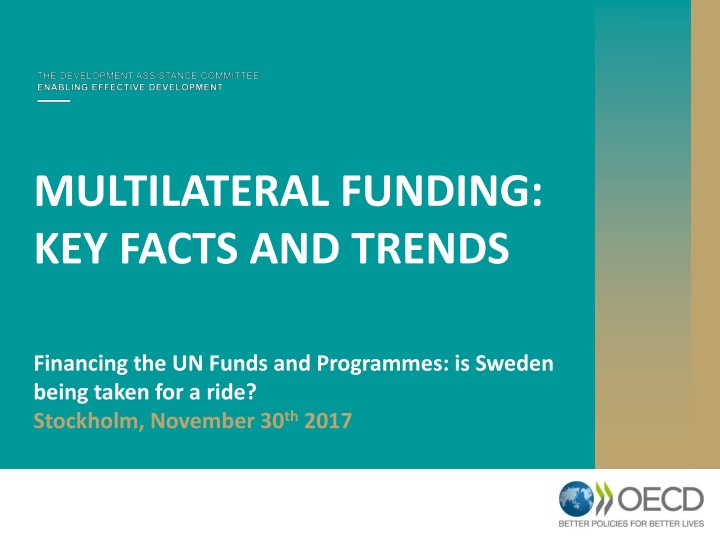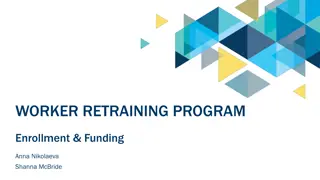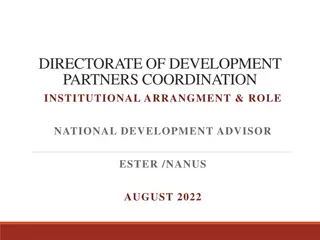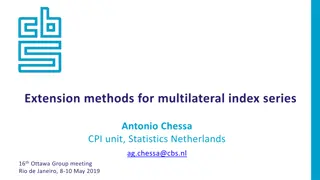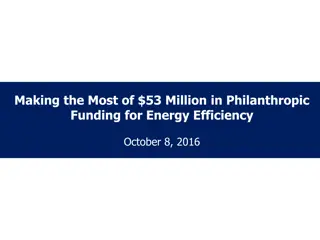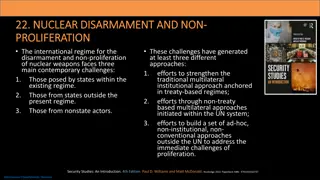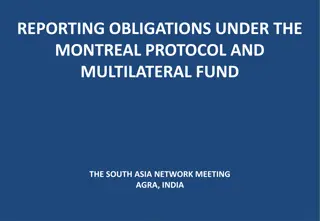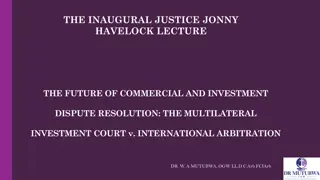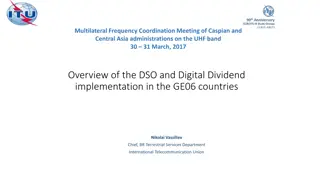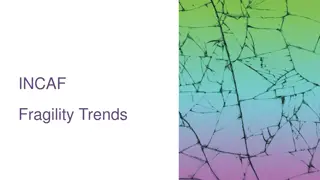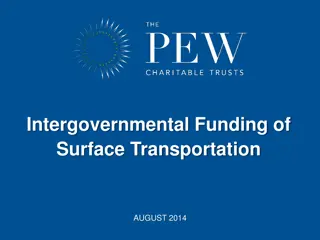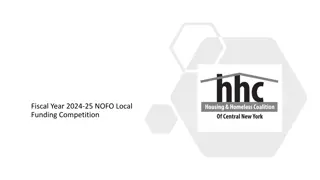Multilateral Funding Trends and Impacts on Global Development
Understanding the shifts in multilateral funding for UN Funds and Programmes is crucial for assessing its impact. Analysis shows a decrease in funding to multilateral organisations, with earmarked funding on the rise. The role of multilateral organisations in reducing global poverty and promoting equality is pivotal in the context of the 2030 Agenda. Examining funding trends reveals evolving practices and their implications for multilateralism.
Download Presentation

Please find below an Image/Link to download the presentation.
The content on the website is provided AS IS for your information and personal use only. It may not be sold, licensed, or shared on other websites without obtaining consent from the author.If you encounter any issues during the download, it is possible that the publisher has removed the file from their server.
You are allowed to download the files provided on this website for personal or commercial use, subject to the condition that they are used lawfully. All files are the property of their respective owners.
The content on the website is provided AS IS for your information and personal use only. It may not be sold, licensed, or shared on other websites without obtaining consent from the author.
E N D
Presentation Transcript
MULTILATERAL FUNDING: KEY FACTS AND TRENDS Financing the UN Funds and Programmes: is Sweden being taken for a ride? Stockholm, November 30th 2017
OECD work on multilateral development finance : a system-wide view: about 2/5 of ODA goes to and through multilateral organisations Where does this money go? Who are the largest contributors? Where are multilateral outflows directed to? How is the architecture of multilateral organisations evolving over time? How are providers funding practices affecting the performance of multilateral organisations? How can providers best spend their ODA money to support multilateral organisations deliver effectively?
Multilateral organisations have historically played a key role to reduce poverty worldwide and promote a more equal world In the era of the 2030 Agenda, their role could be even more important : Image associ e R sultat de recherche d'images pour "global challenges 2030 agenda" Politically-neutral conveners of global partnerships, Vehicles for upstream pooling of resources, Facilitators for multi-stakeholder cross-border operations, and Setters of global standards and norms.
Are current financing trends supporting multilateralism?
FACT #1: Funding to multilateral organisations is decreasing slightly After consecutive increases in 2013 and 2014, in 2015 multilateral funding (USD 55.7 billion) has decreased (-0.5%) and represents now a slightly smaller share of ODA (39%, from 41% in 2014). Source: OECD-DAC, gross disbursements, constant prices, USD billion (2015)
Fact #2: Funding is increasingly tied to specific projects and purposes Only earmarked funding increased in 2015 (+1%) to be offset by the decrease in core resources (-1.2%); Over time, earmarked funding increased much faster than core resources, doubling since 2007 and now represents an increasing share of multilateral funding (33% in 2015, up from 23% in 2007). Source: OECD-DAC, gross disbursements, constant prices, USD billion (2015)
UN funds and programmes are particularly reliant on earmarked funding A need for more core resources and better earmarked funding
Fact #3: Large decreases in multilateral funding mainly in core resources - by some large providers Percentage changes between 2014 and 2015 Source: OECD-DAC, gross disbursements, constant prices, USD billion (2015)
but also some increases Percentage changes between 2014 and 2015 Source: OECD-DAC, gross disbursements, constant prices, USD billion (2015)
Donors engage with multilateral organisations to different degrees and in different ways Source: OECD-DAC, gross disbursements, constant prices, USD billion (2015)
Fact #4: Growing sources of financing beyond sovereign states and DAC providers Private sources, including foundations; Non-DAC providers; Other multilateral organisations (such as vertical funds, EUI, etc) Philanthropic and DAC support for health - 2013-2015 Philanthropic support to multilateral organisations 2013-15
Fact #4: Growing role of non-DAC providers Considerable increase in funding to ODA-eligible multilateral organisations from 7 large non-DAC providers (+51% in 2009-13) but still small compared to DAC members multilateral funding (USD 1.2 billion compared to USD 59 billion in 2013). Set up of new multilateral institutions: the New Bank ( BRICS bank ) and multilateral funds and initiatives under the leadership of China, such as the Asia Infrastructure Investment Bank.
Going forward Evidence-based discussion on the quality of overall financing to multilaterals (core + earmarked) that could deliver pragmatic solutions (i.e. WHO pilot); Implications of a universal development agenda and contribution to Global Public Goods capturing the normative role of multilaterals via TOSSD; New funding models and instruments for sustainably leveraging additional resources; Implications of graduation criteria and transition phases; Systemic complementarity and coherence
Thank you Find out more at: http://www.oecd.org/dac/aid- architecture/multilateralaid.htm
Funding across groups of multilateral organisations Three clusters of multilaterals receive the bulk of funding; Each has a different composition of resources Core and non-core funding in 2015 USD million
Decision-making: some examples DAC country Number of ministries/institutions providing core Number of ministries/institutions providing non-core Share of core provided by the largest provider ministry of core Share of non-core provided by the largest provider ministry of core 94% (Australian Government) 94% (Federal ministry of Finance) 99% (Australian Government) Australia 2 3 57% (Federal ministry of finance) Austria 7 11 40% (Canadian International Development Agency) 62% (Canadian International Development Agency) Canada 6 7 35% (Ministry of the Economy, Finances and Industry) 94% (Ministry for Economic cooperation and development) 76% (Ministry of Foreign Affairs) France 10 10 39% (Foreign Office) Germany 5 6 Japan 4 5 80% (Other ministries) 95% (Ministry of Foreign Affairs and Trade) 100% (Portuguese Government) 92% (Ministry of Foreign Affairs) 100% (Ministry of Foreign Affairs and Trade) 79% (Portuguese Government) New Zealand 2 1 Portugal 2 3 47% (Ministry of Public Administration) 54% (Ministry of Foreign Affairs) Spain 10 15 86% (Swiss Agency for Development and Co- operation) 92% (Department for International Development) 51% (Department of Treasury) 60% (Swiss Agency for Development and Co-operation) Switzerland 4 4 82% (Department for International Development) United Kingdom 8 8 62% (Agency for International Development) United States 5 12
Seven* large providers beyond the DAC account for 2% of flows to multilateral organisations Total funding to multilateral organisations by DAC members and seven* main providers beyond the DAC, 2013 *Brazil, China, India, Saudi Arabia, South Africa, Turkey, United Arab Emirates Source: OECD DAC Multilateral Aid 2015
Multilateral funding increased by 51% in 2009-13 Source: OECD DAC Multilateral Aid 2015
Individual countries increased multilateral funding to different extents Funding to and through multilateral organisations Source: OECD DAC Multilateral Aid 2015
Funding across groups of multilateral organisations Sum of funding in 2009-13, current prices Source: OECD DAC Multilateral Aid 2015
Diversity of providers beyond the DAC Importance of multilateral funding in overall concessional development finance (from less than 7% to 25% or more) Focus institutions (mainly MDBs for China and South Africa, while mainly UN/WBG for the others) Purpose and modalities of partnerships (from humanitarian aid, to own capacity development, to enhancing south-south co-operation) Prospects of future engagement (longer versus short term/ mainly through new or old institutions)
Some commonalities: Need to address old and new systemic issues Some factors hinder greater multilateral engagement of countries beyond the DAC: o Political (limits on voice and representation,concerns about the policy prescriptions attached to lending by international financing institutions) o Economic (reduced scope for grappling mutual benefits ) o Organisational (embryonic development systems, including frameworks and process to provide funding to multilaterals) These factors lead to the establishment of other galaxies of multilateral institutions: o Islamic or Southern institutions in the past, and o the Asia Infrastructure Investment Bank and the New Bank ( BRICS bank ) currently
